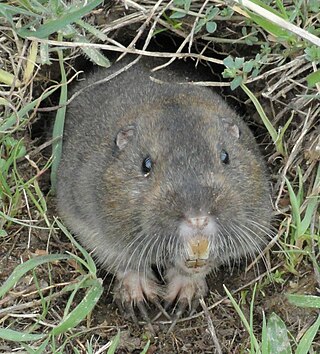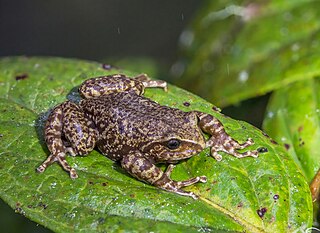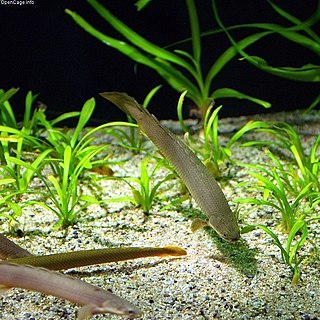Genus is a taxonomic rank used in the biological classification of living and fossil organisms as well as viruses. In the hierarchy of biological classification, genus comes above species and below family. In binomial nomenclature, the genus name forms the first part of the binomial species name for each species within the genus.

In taxonomy, binomial nomenclature, also called binary nomenclature, is a formal system of naming species of living things by giving each a name composed of two parts, both of which use Latin grammatical forms, although they can be based on words from other languages. Such a name is called a binomial name, a binomen, binominal name, or a scientific name; more informally it is also historically called a Latin name. In the ICZN, the system is also called binominal nomenclature, "binomi'N'al" with an "N" before the "al", which is not a typographic error, meaning "two-name naming system".

The family Psittacidae or holotropical parrots is one of three families of true parrots. It comprises the 12 species of subfamily Psittacinae and 167 of subfamily Arinae including several species that have gone extinct in recent centuries. Some of the most iconic birds in the world are represented here, such as the blue-and-yellow macaw among the New World parrots and the grey parrot among the Old World parrots.

Starlings are small to medium-sized passerine birds in the family Sturnidae. The Sturnidae are named for the genus Sturnus, which in turn comes from the Latin word for starling, sturnus. The family contains 128 species which are divided into 36 genera. Many Asian species, particularly the larger ones, are called mynas, and many African species are known as glossy starlings because of their iridescent plumage. Starlings are native to Europe, Asia, and Africa, as well as northern Australia and the islands of the tropical Pacific. Several European and Asian species have been introduced to these areas, as well as North America, Hawaii, and New Zealand, where they generally compete for habitats with native birds and are considered to be invasive species. The starling species familiar to most people in Europe and North America is the common starling, and throughout much of Asia and the Pacific, the common myna is indeed common.

Chevrotains, or mouse-deer, are diminutive, even-toed ungulates that make up the family Tragulidae, and are the only living members of the infraorder Tragulina. The 10 extant species are placed in three genera, but several species also are known only from fossils. The extant species are found in forests in South and Southeast Asia; a single species, the water chevrotain, is found in the rainforests of Central and West Africa. They are solitary, or live in loose groupings or pairs, and feed almost exclusively on plant material. Chevrotains are the smallest hoofed mammals in the world. The Asian species weigh between 0.7 and 8.0 kg, while the African chevrotain is considerably larger, at 7–16 kg (15–35 lb). With an average length of 45 cm (18 in) and an average height of 30 cm (12 in), the Java mouse-deer is the smallest surviving ungulate (hoofed) mammal, as well as the smallest artiodactyl. Despite their common name of "mouse deer", they are not closely related to true deer.

The Geoemydidae are one of the largest and most diverse families in the order Testudines (turtles), with about 70 species. The family includes the Eurasian pond and river turtles and Neotropical wood turtles. Members of this family are commonly called Leaf turtle.

The Lacertidae are the family of the wall lizards, true lizards, or sometimes simply lacertas, which are native to Afro-Eurasia. It is a diverse family with at about 360 species in 39 genera. They represent the dominant group of reptiles found in Europe.
In biology, a monotypic taxon is a taxonomic group (taxon) that contains only one immediately subordinate taxon. A monotypic species is one that does not include subspecies or smaller, infraspecific taxa. In the case of genera, the term "unispecific" or "monospecific" is sometimes preferred. In botanical nomenclature, a monotypic genus is a genus in the special case where a genus and a single species are simultaneously described. In contrast, an oligotypic taxon contains more than one but only a very few subordinate taxa.

In zoological nomenclature, a type species is the species name with which the name of a genus or subgenus is considered to be permanently taxonomically associated, i.e., the species that contains the biological type specimen. A similar concept is used for suprageneric groups and called a type genus.

The subfamily Talpinae, sometimes called "Old World moles" or "Old World moles and relatives", is one of three subfamilies of the mole family Talpidae, the others being the Scalopinae, or New World moles, and the Uropsilinae, or shrew-like moles.

Pocket gophers, commonly referred to simply as gophers, are burrowing rodents of the family Geomyidae. The roughly 41 species are all endemic to North and Central America. They are commonly known for their extensive tunneling activities and their ability to destroy farms and gardens.
In zoological nomenclature, the specific name is the second part within the scientific name of a species. The first part of the name of a species is the name of the genus or the generic name. The rules and regulations governing the giving of a new species name are explained in the article species description. For example, the scientific name for humans is Homo sapiens, which is the species name, consisting of two names: Homo is the "generic name" and sapiens is the "specific name".
The bluntsnout smooth-head, black slickhead, cope's bluntsnout smooth-head, or Atlantic gymnast, Xenodermichthys copei, is a slickhead of the genus Xenodermichthys, found in the Atlantic, Indian, and Pacific oceans, and the Tasman Sea, at depths of 100 to 2,600 m. This species grows to a length of 31 centimetres (12 in) TL.

Kinixys is a genus of turtles in the family Testudinidae. The genus was erected by Thomas Bell in 1827. The species in the genus Kinixys are native to Sub-Saharan Africa and Madagascar and commonly known as hinged tortoises or hinge-back tortoises.

In biology, taxonomic rank is the relative level of a group of organisms in an ancestral or hereditary hierarchy. A common system of biological classification (taxonomy) consists of species, genus, family, order, class, phylum, kingdom, and domain. While older approaches to taxonomic classification were phenomenological, forming groups on the basis of similarities in appearance, organic structure and behaviour, methods based on genetic analysis have opened the road to cladistics.

Pristimantis is a very large genus of frogs distributed in the southern Caribbean islands and in Central and South America from Honduras to northern Argentina and southern Brazil. With 596 described species, the genus had more species than any other genus of vertebrate animals. Many of these species genus are endemic to the Northwestern Andean montane forests ecoregion in north-western South America.

Cladistia is a clade of bony fishes whose only living members are the bichirs. Their major synapomorphies are a heterocercal tail in which the dorsal fin has independent rays, and a posteriorly elongated parasphenoid.

The Nemacheilidae, or stone loaches, are a family of cypriniform fishes that inhabit stream environments, mostly in Eurasia, with one genus, Afronemacheilus found in Africa. The family includes about 790 species.
Veloxidium is a genus of parasitic alveolates in the phylum Apicomplexa. Species in this genus infect marine invertebrates.
Siedleckia are a genus of parasitic alveolates in the phylum Apicomplexa. Species in this genus infect marine invertebrates.














